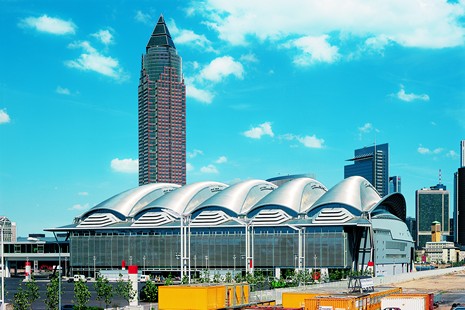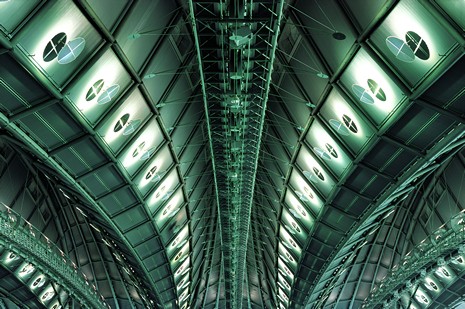Description
For almost twenty years architects like Oswald Mathias Ungers and Helmut Jahn have shaped the image and corporate identity of the Messe Frankfurt with their exemplary exhibition architecture. Altogether, ten different halls complement each other in terms of functionality and design and thereby form a harmonic whole.
Nicholas Grimshaw’s Trade Fair Hall 3, completed in 2001, borders with its long side on the central square of the exhibition grounds. This way, the urban layout is rounded off towards the south. The architect filled the client’s requirements for a bright, neutral atmosphere of the exhibition hall and a maximum of enclosed space by creating one of Europe’s largest column-free halls, covered by a unique roof structure. The exhibition area of 38,000 m² spreads over two storeys and is supplemented by two four-storey buildings with foyers at the hall’s gable ends. The roof structure spans the length rather than the width of the building; thus, the north façade facing the forum could be generously opened up. The undulating roof is a continuous folded-plate structure, composed of a net of straight tubular steel members. It freely spans 165 m and rests on twelve so-called A-frames. The structure of the upward-swinging roof is composed of five “waves”. The intrados of the waves consist of a net of pressure members while a net of tensioned members forms the upper concave parts. The 30,000 m² roof is clad with prefabricated stressed steel sandwich panels with an in-built twist which follow the roof geometry. Despite the fancy shape, only 60 different polygonal panel types were required for the entire roof area due to the repetitive structure of the system.
Due to the wave-shape of the roof a high degree of sound absorption is achieved. Despite the height of the hall, the roof’s maximum rise is clearly lower than conventional arched structures. Thus, the air-conditioning volume of the hall could be kept at bay. The expressive roof shape is also favorable for natural air extraction and offers air-reserves for ventilation and smoke control. The clear roofline is accentuated by integrated strips of skylights while the mechanical equipment has been installed unobtrusively in the ceiling cavity between both exhibition levels.
Drawings
Ground floor
Upper level
Floor plan diagram
Cross section
Longitudinal section
Schematic Axonometric view of A-frame
Photos

Southwest view of Trade Fair Hall 3 with the Messeturm by Helmut Jahn in the background

Interior view of the load-bearing structure showing the mirror system suited to the roof geometry for glare-free day-lighting of the hall
Originally published in: Jürgen Adam, Katharina Hausmann, Frank Jüttner, Industrial Buildings: A Design Manual, Birkhäuser, 2004.